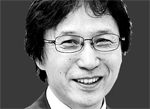Korea needs foreign workers

Shin Jang-sup
Today’s star pupil among the high-income group of nations is Germany. It fared well through the difficult transition after unification and now plays the main engine driving the otherwise slow-moving euro zone economy.
But studies on growth rates of these economies do not pinpoint strengths in competitiveness as many typically think. From 1991 to 2012, Japan grew at an annual rate of 1.04 percent, the United States at 2.61 percent and Germany at 1.67 percent. But growth per total labor force shows less of a disparity. Japan grew by an average 0.91 percent, the United States by 1.62 percent and Germany by 0.87 percent. Japan is just slightly ahead of Germany. In 2000 alone, Japan’s output per worker grew about the same as the United States.
The gaps in growth among the three advanced economies could be explained by demographic differences and work forces. Over the last two decades, the U.S. labor force increased by 23 percent while that of Japan added just 0.6 percent. William Cline, a senior fellow at the Peterson Institute for International Economics, called the lost decade theory for Japan an optical illusion caused by demographics and stagnant growth in the work force in Japan due to aging and limited immigration. Policy makers and economists had been barking up the wrong tree with all their hype about a failed economic model and deflation being the cause of Japan’s recession.
Behind the similar growths in working populations in the United States and Germany were aggressive immigration policies designed to attract foreign labor. America has always been a melting pot of races. Immigration is common there. Germany is generally known to be prejudiced against foreign blood due to the Third Reich era and anti-Semitism of Adolf Hitler. But Germany is populated with many people of mixed ethnic ancestry. Many people immigrate to Germany. Of the 23 members of the German national team in the World Cup matches in 2010, 11 were naturalized citizens. It has become one of the most multi-racial countries.
Japan on the other hand remains hostile to immigrants. The aging of its population is the fastest among advanced economies. Its fertility rate also sagged. It was solely due to its industrial power that the country somehow managed to generate about 1 percent in output growth over the last 20 decades even with such a thinning work force. Yet Japan has been cited as a poor model of “the success that soured” in its two lost decades, because of stagnation in its labor force rather than in its economic activity.
The biggest challenge to the global economy is an aging population. People are expected to live longer - up to 100 - and yet young people shun marriage or having children. Even if they decide to raise a family, they are content with one child. In today’s society, the state cannot force people to marry and have children. A public campaign cannot be expected to encourage people to have more children. Moreover, it will be years before such children grow up and work.
The practical solution for now is to attract foreign people capable of working and paying taxes. Countries are in a race to attract eligible taxpayers because they all face the common problem of aging populations. The United States and Germany already have established immigration systems and are competitive in the demographic contest. Other countries like Japan are not.
Japan’s problems today are ours tomorrow. Korea is aging at an even quicker pace than Japan. Our fertility rate is the world’s lowest. We basically have no immigration policy. One day in the very near future we will kick ourselves when a stagnation in our work force gets blamed for a structural slowing in output and growth.
Compared with Japan, Korea is better qualified to attract a foreign labor force. There are even Japanese citizens who would choose to live in Korea over their own country, plagued as it is with earthquakes, environmental uncertainties and a nuclear power plant crisis. Korea’s proximity to China should be appealing to Chinese migrants. Many in the developing world would find Korea alluring for its success, glitzy technology and entertainers. Korea should quickly come up with a system to pull these people in, encourage them to invest and create a new work force and jobs.
Japanese Prime Minister Shinzo Abe, who promised to pull his economy out of the gutter for good, announced last month that Japan will try to attract 200,000 immigrants every year. If it doesn’t act now, Japan is in danger of losing its very work force. No country is better witness to Japan’s ups and downs than Korea. It must learn from Japan’s blunders.
Translation by the Korea JoongAng Daily staff.
JoongAng Sunday, March 16, Page 35
*The author is an economics professor at the National University of Singapore.
By Shin Jang-sup










with the Korea JoongAng Daily
To write comments, please log in to one of the accounts.
Standards Board Policy (0/250자)